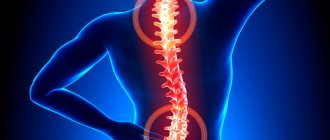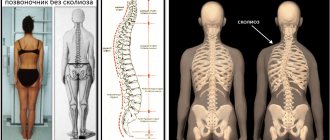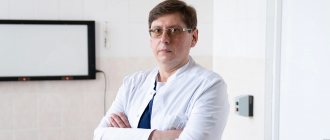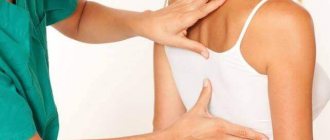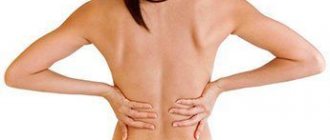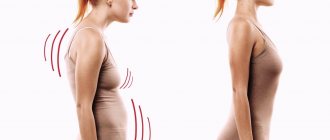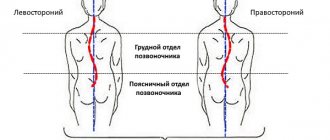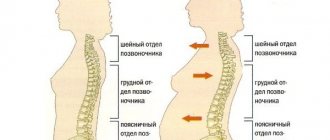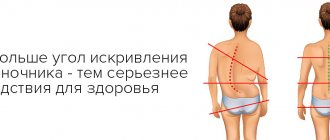Up to 89% of the population is susceptible to various diseases of the spinal column. The most common disease at a young age is scoliosis. This pathology can be treated both surgically and conservatively. For example, manual therapy for scoliosis is of great importance among other techniques. It helps to align misaligned spinal segments, providing the best healing effect.
Prices for manual therapy treatment
| SERVICES LIST | PRICE, RUB. |
| Soft manual techniques (45-60 min.) | 7 500 |
| Osteopathic techniques (30-75 min.) | 7 500 |
| Magnetic Vacuum Acupuncture | 1 600 |
| Intra-articular administration of a drug (excluding the cost of the drug) | 4 400 |
| Intra-articular injection (diprospan) | 5 500 |
| Orthoplasma into the joint | 7 000 |
| Intra-Articular PRP Injection | 6 500 |
| PRP therapy for tendonitis, ligamentitis, contractures | 6 500 |
Contact us
Call now
8 (495) 803-27-45
Make an appointment through our service
Make an appointment
Indications for treatment
The development of a recovery program using manual therapy methods is carried out individually for each patient, depending on the characteristics of the disease and the physical condition of the patient.
Indications for its implementation are:
- Curvature of stages 1-3, when the angle of displacement of the vertebrae does not exceed 50ᵒ.
- Congenital developmental disorders of the musculoskeletal system, characterized by shortening of the legs, which leads to deviation of the spine from the central axis.
- Scoliosis caused by incorrect posture, which is formed as a result of excessive loads on the spine, non-compliance with rest and work regimes.
- The specialist diagnosed “scoliotic disease of the spine” (deformation of the vertebrae due to developmental anomalies or acquired during life).
The need for mandatory diagnostics
A balanced approach to the problem, both of the patient himself and of the specialist himself, is a guarantee of curing the pathology. Before proceeding with any manipulations, it is necessary to establish an accurate diagnosis. In order to understand the severity of the disease and build a treatment plan, the following diagnostic measures are necessary:
- survey and visual assessment of condition;
- scoliometry;
- measuring the patient's weight and height;
- X-ray examination of the entire spinal column in various projections;
- determination of lung volume;
- carrying out magnetic resonance imaging.
In certain cases, even some laboratory diagnostic methods are required. They are necessary to exclude or identify concomitant diseases. Some of them may be absolute contraindications to manual therapy for scoliosis.
Initial appointment and examination of the patient
At the initial appointment, the chiropractor prescribes a detailed examination, which is carried out using laboratory and instrumental methods and includes:
- General analysis of urine and blood - to determine inflammation that occurs in an asymptomatic form.
- An electrocardiogram to assess the functioning of the cardiovascular system.
- X-ray or MRI to determine details of the pathology (examination of displaced segments of the spine).
The patient may undergo an X-ray or CT scan, but the results of these diagnostic methods do not provide a complete picture of the condition of the soft tissues and vertebrae.
A comprehensive examination helps to determine the risks for the patient’s physical condition and individually create a health-improving course program (including calculating the number of procedures). The total number of treatment sessions should not exceed 15 procedures within one year, otherwise manual therapy may cause excessive mobility of the vertebrae and joints. This will cause a worsening of the underlying disease (progression of scoliosis).
On the day of your initial appointment with any doctor in our Neurology clinic, you can undergo manual therapy or massage with a 25% discount. This way you can form an objective opinion about the services of our clinic and the quality of work of our specialists. And if after this you decide to pay for the full course of further procedures, you will receive a 10% discount on the course of treatment.
How to prevent poor posture and scoliosis in a child?
Do not sit down an infant before he does it himself. Do not carry the child in the same arm, do not lead him by the same hand. The child needs furniture according to his height. The student's workplace should be well lit, the light should fall from the left. The workspace of the desk should be spacious enough: it should accommodate not only a book and a notebook, but also elbows; if a child slouches over the table while reading or writing, it is necessary to have his eyesight checked; the child may need glasses. It is also not recommended to read or watch TV while lying on your side. Intense schoolwork must be compensated for by active rest, walks, and sufficient sleep.
The harmonious physical development of the child is no less important. His gymnastic “diet” should include both fast movements of morning exercises familiar to everyone from kindergarten, and “toffee” exercises - at a slow pace, improving the elasticity of the muscles. No less important are outdoor games: climbing, crawling, tumbling, running. Swimming is very beneficial. During the period of rapid growth, you should refrain from jumping from heights and long running.
Good nutrition is the most important factor. In search of an essential component of bones—calcium—many children gnaw school chalk with appetite. Chalk, as you know, is not the most delicious dish. The child’s diet should contain enough dairy products, vegetables and fruits, fish - natural sources of calcium and vitamins.
Do not forget about the influence of the emotional state on the motor stereotype. Children suffering from neuroses are prone to stooping. Everyone knows: a healthy psychological climate in the family is an inoculation against almost all diseases.
Manual treatment of scoliosis of varying degrees
For scoliosis of the 1st degree, massage allows you to correct poor posture and strengthen the muscle corset in the back and chest. Therapeutic procedures have a preventive effect, forming the correct position of the segments of the musculoskeletal system, excluding the development of a pathological condition in the future. In addition to massage, exercise therapy may be prescribed (exercises are necessary to maintain correct posture).
At stage 2 of the disease, changes in the position of the vertebrae become noticeable, so procedures are aimed at eliminating the main symptoms of deformity.
Scoliosis of 3 and 4 degrees requires massage of high intensity and duration. The chiropractor uses deep rubbing techniques, kneading the back on the side where the displaced vertebrae protrude.
If a patient is diagnosed with an S-shaped curvature of the spinal column, then the most serious treatment by qualified specialists with extensive experience is required. This type of pathology requires separate treatment of 4 areas of the back.
Symptoms
- Scoliosis curve 26-40°
- There may be a forward head tilt, uneven shoulders or hips
- Clothes may fit unevenly
- Often one shoulder blade is higher than the other and a “rib hump” appears.
- Pain may or may not be present
- The patient may feel tired after physical activity
- Often the patient feels “awkward”
- Patients may experience pain in the spine, most commonly between the shoulder blades and at the base of the chest
Features of scoliosis treatment with manual therapy
Treatment of scoliosis involves three types of massage aimed at warming up the muscles, realigning and intensively massaging the vertebrae, followed by relaxation.
The implementation of the recovery program is carried out taking into account the basic rules:
- The patient must be kept completely still.
- Straightening the spine to the maximum possible position (physiological) should occur without pain.
- The massage technique should take into account the age, physical condition of the patient, the degree of development of pathology and concomitant diseases.
- Before carrying out acupuncture treatment, the specialist needs to localize the affected areas, identify compactions and areas with increased muscle tone.
- When working out, the optimal intensity and depth of impact is selected for each muscle group.
Classification
Treatment tactics depend on the type of scoliosis. According to the time of appearance, it can be congenital and acquired, according to the form of deformation - C-shaped (with one arc of curvature), S-shaped (with two arcs), Z-shaped (with three arcs).
Based on severity, there are 4 degrees of scoliosis:
- less than 10o;
- 10-25o;
- 25-50o;
- more than 50o.
Based on location, scoliosis is classified into the thoracic, lumbar and sacral regions. With combined scoliosis, the spine is curved in several areas. Source: A.P. Kulikov, T.N. Zaitseva, O.P. Pyzhevskaya, E.R. Ivanova Scoliosis in children: new approaches to solving an important medical and social problem // Medical and social examination and rehabilitation. 2016; 19(4), pp.178-181
Positive effects of manual therapy for scoliosis
Patients who have quite serious deviations in the position of the spinal column most often come to see a chiropractor, which is due to the inconspicuous course of the disease in the early stages. A problem with posture becomes noticeable when the angle of vertebral displacement reaches 8-10ᵒ. The pathology is characterized by changes in the level of the shoulders relative to each other and disturbances in the chest. Curvature of the spine is accompanied by dull pain, limited ability to move, and in later stages pathologies of internal organs may occur.
Manual therapy according to an individually developed program allows you to relieve excess muscle tension that occurs with scoliosis of the 2nd degree and more severe forms. The specialist then realigns the vertebrae. Treatment involves 10 to 15 massage sessions, which can significantly reduce the angle of deviation of the spinal column and ensure remission of the disease for a long time. Wearing a corset, which corrects posture, has a positive effect.
A course of manual therapy is carried out in combination with other procedures to enhance the effect of treatment. Depending on the diagnosis, this may be acupuncture, physiotherapy, osteopathy, etc. These procedures complement each other and can be completed in our center.
What is poor posture? What are the reasons for its appearance?
Poor posture is caused by a muscle tone-strength imbalance. Poor posture is an almost completely reversible process that is not associated with structural changes in the supporting structures of the spine. The reason for this is the “non-involvement” of one, two or three muscles in maintaining the physiological position of the body. Poor posture is reversible, because caused by errors in the control of posture and movement of nerve centers.
Why does the nervous system allow these “failures”? The nervous system receives information about the position of the body, the degree of tension of a particular muscle, the load on a particular joint from numerous sensory receptors and uses this information to control the muscles. The trigger for poor posture can be any factor that distorts, blocks or “clogs” the transmission of signals from receptors - an uncomfortable posture at work or at school, abdominal pain, previous injuries and much more. Unfortunately, an already formed violation of posture cannot be corrected only by forcibly maintaining the correct posture. Modern treatment principles make it possible to solve this problem radically - to find the cause of the disorder and retrain the neuromuscular system. The effect is visible already at the first meeting with the doctor.
Who will treat you?
The Innovative Medical Center employs qualified specialists who deal with the treatment of such spinal diseases every day. Numerous reviews on our website and other sources on the Internet confirm the high level of services provided.
Dremin Evgeniy Vitalievich
neurologist, reflexologist, chiropractor.
6 years of experience. More details
Contraindications
Some therapeutic procedures may be limited in use with the following contraindications:
- If the cause of the curvature is traumatic injury.
- The patient was diagnosed with a malignant tumor of any location.
- The functioning of the cardiovascular system is disrupted.
- There are inflammatory processes.
- Reduced bone density.
- Spinal cord compression due to various reasons was diagnosed.
- There are skeletal developmental defects caused by hereditary factors.
- Young age of the patient.
Since the list of contraindications is quite extensive, the patient undergoes a comprehensive examination before the procedures are prescribed. This is necessary to exclude the presence of diseases and pathologies that impede treatment.
Placement of rods during scoliosis correction surgery
Benefits of Scoliosis Correction Rod Placement
- Eliminates the need for plaster casting
- The patient can be mobilized earlier
- Recurrence of scoliosis is very rare.
- Prolonged casting is not tolerated by the patient
Disadvantages of placing rods for scoliosis correction
- The operation takes longer
- Bleeding and post-hematomas are common
- The rods may break.
Surgical complications during surgical correction of scoliosis
- Bleeding
- Infections
- Soft tissue injury
- Soft tissue inflammation
- Breathing problems
- Nerve injury
Prognosis after treatment
- After surgery, scoliosis patient experiences improved breathing
- Patients with scoliosis experience reduced pain after treatment with bracing, exercise therapy and surgery
- Improved range of motion
- Increased exercise tolerance
